

Task 3. The 13 largest oil spills in history. When the Deepwater Horizon oil rig sank in the Gulf of Mexico on April 22, no one was prepared for the massive environmental disaster that followed.
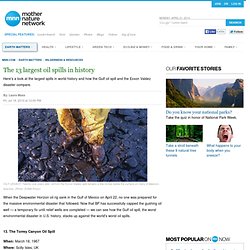
Now that BP has successfully capped the gushing oil well — a temporary fix until relief wells are completed — we can see how the Gulf oil spill, the worst environmental disaster in U.S. history, stacks up against the world's worst oil spills. 13. The Torrey Canyon Oil Spill When: March 18, 1967Where: Scilly Isles, UKAmount spilled: 25-36 million gallons. Compare the Exxon Valdez and BP Oil Spills. Top 10 Worst Oil Spills. The oil gushing from the well where the Deepwater Horizon oil rig exploded and sank is now spreading through the Gulf of Mexico.
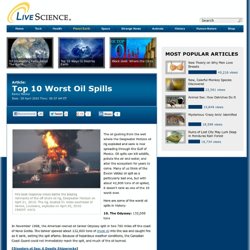
Oil spills can kill wildlife, pollute the air and water, and alter the ecosystem for years to come. Many of us think of the Exxon Valdez oil spill as a particularly bad one, but with about 42,800 tons of oil spilled, it doesn't rank as one of the 10 worst ever. Here are some of the worst oil spills in history: 10. The Odyssey: 132,000 tons In November 1988, the American-owned oil tanker Odyssey split in two 700 miles off the coast of Nova Scotia. . [ Disasters at Sea: 6 Deadly Shipwrecks ] 9. Task 2. Oil plagues sound 20 years after Valdez - US news - Environment. Twenty years after the Exxon Valdez spilled 11 million gallons of crude oil in Alaska's Prince William Sound, oil persists in the region and, in some places, "is nearly as toxic as it was the first few weeks after the spill," according to the council overseeing restoration efforts.
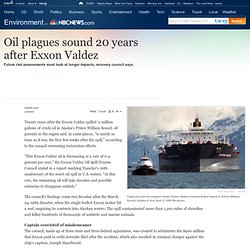
"This Exxon Valdez oil is decreasing at a rate of 0-4 percent per year," the Exxon Valdez Oil Spill Trustee Council stated in a report marking Tuesday's 20th anniversary of the worst oil spill in U.S. waters. "At this rate, the remaining oil will take decades and possibly centuries to disappear entirely. " The council's findings come two decades after the March 24, 1989 disaster, when the single-hulled Exxon tanker hit a reef, emptying its contents into Alaskan waters. The spill contaminated more than 1,200 miles of shoreline and killed hundreds of thousands of seabirds and marine animals. Hazelwood, was accused but then acquitted on a charge of being drunk at the time. . © 2013 msnbc.com Reprints. KEFJ_EVOS_1989-2009_qa. Exxon Valdez Oil Spill: 20 Years Later. John Platt - a fisherman from Cordova, Alaska - made a pretty penny in the good old days.

That was back in the 80's when an Alaskan fisherman could work hard and make a good living. That was then. This is now. "My current financial situation is terrible," Platt says, "It's terrible. " He still earns his living fishing. "My net worth is negative right now," he says. The 13 largest oil spills in history. The Exxon Valdez spill was in 1989, they still, 21 years later, have not paid the [full] amount awarded in court (a mere $500 million) to those affected and in fact over 8000 people have died while waiting for compensation. Exxon is still in appeals court.
Exxon and BP’s broken record Many would assume that BP””the company responsible for the Gulf Coast disaster””will cover the entire cost of cleanup.
![The Exxon Valdez spill was in 1989, they still, 21 years later, have not paid the [full] amount awarded in court (a mere $500 million) to those affected and in fact over 8000 people have died while waiting for compensation. Exxon is still in appeals court](http://cdn.pearltrees.com/s/pic/th/awarded-affected-compensation-57550884)
But we learned from the Exxon Valdez spill that the reality is very different: The Exxon Valdez tanker spilled more than 11 million gallons of crude oil into Alaska’s Prince William Sound, which eventually contaminated approximately 1,300 miles of shoreline. The total costs of Exxon Valdez, including both cleanup and also “fines, penalties and claims settlements,” ran as much as $7 billion. Cleanup of the affected region alone cost at least $2.5 billion, and much oil remains. Yet Exxon made high profits even in the aftermath of the most expensive oil spill in history. Exxon fought paying damages and appealed court decisions multiple times, and they have still not paid in full.
Twenty years later, some of the original plaintiffs are no longer alive to receive, or continue fighting for, their damages. BP profits while disaster unfolds. Letter Head. Alternate D.I.S.C. Logo. Task 1. Enviro_t1. Chives's Job. Oil spill book. Darell's Job. Exxon Valdez oil spill. Read about the BP Deepwater Horizon oil spill in the Gulf of Mexico.
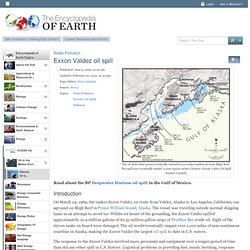
Introduction On March 24, 1989, the tanker Exxon Valdez, en route from Valdez, Alaska to Los Angeles, California, ran aground on Bligh Reef in Prince William Sound, Alaska. The vessel was traveling outside normal shipping lanes in an attempt to avoid ice. Within six hours of the grounding, the Exxon Valdez spilled approximately 10.9 million gallons of its 53 million gallon cargo of Prudhoe Bay crude oil. Eight of the eleven tanks on board were damaged. The response to the Exxon Valdez involved more personnel and equipment over a longer period of time than did any other spill in U.S. history.
Shoreline cleanup began in April of 1989 and continued until September of 1989 for the first year of the response. The images that the world saw on television and descriptions they heard on the radio that spring were of heavily oiled shorelines, dead and dying wildlife, and thousands of workers mobilized to clean beaches. Group Pearl. Exxon Valdez Oil Spill Trustee Council - Source: 1993 State On-Scene Coordinator's Report.
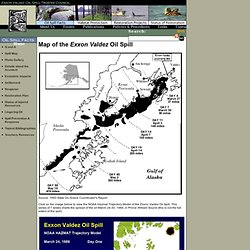
Exxon Valdez Oil Spill - Profile - Exxon Valdez Oil Spill. The 1989 Exxon Valdez oil spill—which fouled the waters of Prince William Sound, coated more than a thousand miles of pristine coastline, and killed hundreds of thousands of birds, fish and animals—has become a symbol of human-caused environmental disasters.

Many years after the accident, and despite billions of dollars spent on cleanup efforts, crude oil can still be found under the rocks and sand on the beaches of southwest Alaska, and the effects of the spill are still apparent in the lasting damage done to many native species. Date and Location of the Exxon Valdez Oil Spill: Ishan's Job. KEFJ_EVOS_1989-2009_qa. Exxon Valdez Oil Spill - Economic Impact of Exxon Valdez Oil Spill - How Did the Exxon Valdez Oil Spill Affect the Economy. What Was the Exxon Valdez Oil Spill?
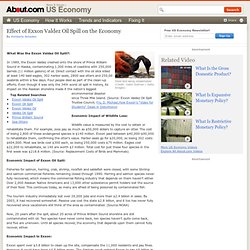
: In 1989, the Exxon Valdez crashed onto the shore of Prince William Sound in Alaska, contaminating 1,300 miles of coastline with 250,000 barrels (11 million gallons) of oil. Direct contact with the oil slick killed at least 140 bald eagles, 302 harbor seals, 2800 sea otters and 250,00 seabirds within a few days. Four people died as part of the clean-up efforts. Exxon Valdez Oil Spill Trustee Council - Where is the Exxon Valdez today?
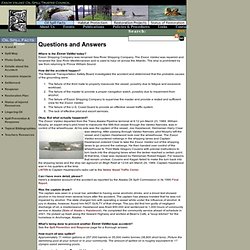
Exxon Shipping Company was renamed Sea River Shipping Company. The Exxon Valdez was repaired and renamed the Sea River Mediterranean and is used to haul oil across the Atlantic. The ship is prohibited by law from returning to Prince William Sound. EXXON VALDEZ OIL SPILL: Ten Years Later. EXXON VALDEZ OIL SPILL: Ten Years Later Technical Background Paper for Alaska Wilderness League by Pamela A. Miller, Arctic Connections 3/99 I am satisfied that tanker traffic to and from Port Valdez, and operation of an oil port there will not cause any significant damage to the marine environment or to fisheries interests.
" --L.R. Our nation's largest oil spill. Four minutes after midnight on March 24, 1989 the Exxon Valdez hit Bligh Reef in Alaska's Prince William Sound. Exxon says that the Sound has recovered. Could it happen again? Oil plagues sound 20 years after Valdez - US news - Environment. Twenty years after the Exxon Valdez spilled 11 million gallons of crude oil in Alaska's Prince William Sound, oil persists in the region and, in some places, "is nearly as toxic as it was the first few weeks after the spill," according to the council overseeing restoration efforts.
"This Exxon Valdez oil is decreasing at a rate of 0-4 percent per year," the Exxon Valdez Oil Spill Trustee Council stated in a report marking Tuesday's 20th anniversary of the worst oil spill in U.S. waters. "At this rate, the remaining oil will take decades and possibly centuries to disappear entirely. " The council's findings come two decades after the March 24, 1989 disaster, when the single-hulled Exxon tanker hit a reef, emptying its contents into Alaskan waters. The spill contaminated more than 1,200 miles of shoreline and killed hundreds of thousands of seabirds and marine animals.
Hazelwood, was accused but then acquitted on a charge of being drunk at the time. Cristel's Job. Senator Murkowski's CBS Interview on Exxon Valdez Oil Spil. Emergency Management. On March 24, 1989, shortly after midnight, the oil tanker Exxon Valdez struck Bligh Reef in Prince William Sound, Alaska, spilling more than 11 million gallons of crude oil. The spill was the largest in U.S. history and tested the abilities of local, national, and industrial organizations to prepare for, and respond to, a disaster of such magnitude. Many factors complicated the cleanup efforts following the spill. The size of the spill and its remote location, accessible only by helicopter and boat, made government and industry efforts difficult and tested existing plans for dealing with such an event. The spill posed threats to the delicate food chain that supports Prince William Sound's commercial fishing industry.
Also in danger were ten million migratory shore birds and waterfowl, hundreds of sea otters, dozens of other species, such as harbor porpoises and sea lions, and several varieties of whales. DISC Logo. Contacts. Emergency Management. For more information on emergency management at EPA, please contact EPA headquarters or one of the regional offices, or use one of our information centers: To report an oil or chemical spill, contact the National Response Center at 800-424-8802.
If you have comments about content information, or want to report a broken link, please email us at OEM_Homepage@epa.gov. View Frequent Questions / Ask a Question Search frequently asked questions or submit your own question or comments in the Emergency Management section of EPA's Frequent Questions Database. Top of page EPA Headquarters Emergency Management Staff U.S. To contact a specific individual, use the EPA employee directory. Superfund, TRI, EPCRA, RMP & Oil Information Center The Superfund, TRI, EPCRA, RMP & Oil Information Center (also referred to as “the Call Center”) is a publicly accessible service that provides up-to-date information on several EPA programs. Hours of Operation: Monday - Friday: 10:00 AM - 5:00 PM Eastern Time.